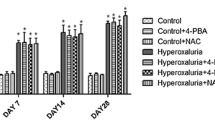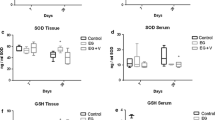Abstract
Role of glutathione on kidney mitochondrial integrity and function during stone forming process in hyperoxaluric state was investigated in male albino rats of Wistar strain. Hyperoxaluria was induced by feeding ethylene glycol (EG) in drinking water. Glutathione was depleted by administering buthionine sulfoximine (BSO), a specific inhibitor of glutathione biosynthesis. Glutathione monoester (GME) was administered for supplementing glutathione. BSO treatment alone or along with EG, depleted mitochondrial GSH by 40% and 51% respectively. Concomitantly, there was remarkable elevation in lipid peroxidation and oxidation of protein thiols. Mitochondrial oxalate binding was enhanced by 74% and 129% in BSO and BSO + EG treatment. Comparatively, EG treatment produced only a 33% increase in mitochondrial oxalate binding. Significant alteration in calcium homeostasis was seen following BSO and BSO + EG treatment. This may be due to altered mitochondrial integrity and function as evidenced from decreased activities of mitochondrial inner membrane marker enzymes, succinate dehydrogenase and cytochrome-c-oxidase and respiratory control ratio and enhanced NADH oxidation by mitochondria in these two groups. NADH oxidation (r = -0.74) and oxalate deposition in the kidney (r = -0.70) correlated negatively with mitochondrial glutathione depletion. GME supplementation restored normal level of GSH and maintained mitochondrial integrity and function, as a result of which oxalate deposition was prevented despite hyperoxaluria. These results suggest that mitochondrial dysfunction resulting from GSH depletion could be a contributing factor in the development of calcium oxalate stones.
Similar content being viewed by others
References
Otnes B: Correlation between causes and composition of urinary stones. Scand J Urol Nephrol 17: 93–99, 1983
Abraham PA, Smith CL: Medical evaluation and management of Calcium oxalate nephrolithiasis. Med Clin North Am 68: 281–286, 1984
Hackett RL, Shevock PN, Khan SR: Cell injury associate calcium oxalate crystalluria. J Urol 144: 1535–1538, 1990
Selvam R, Sridevi D: Oxalate binding to rat kidney mitochondria: Induction by oxidised glutathione. Ind J Biochem Biophys 33: 62–65, 1996
Strzelecki T, McGraw BR, Scheid CR, Menon M: Effect of oxalate on function of kidney mitochondria. J Urol 141: 423–427, 1989
Selvam R, Bijikurien T: Induction of lipid peroxidation by oxalate in experimental rat urolithiasis. J Biosci 12: 367–373, 1987
Selvam R, Bijikurien T: Methionine feeding prevents kidney stone deposition by restoration of free radical mediated changes in experimental rat urolithiasis. J Nutr Biochem 2: 644–651, 1991
Selvam R, Ravichandran V: Restoration of tissue antioxidants and prevention of renal stone deposition in vitamin B6 deficient rats fed with vitamin E or methionine. Ind J Expt Biol 31: 882–887, 1993
Chance B, Sies H, Boveris A: Hydroperoxide metabolism in mammalian organs. Physiol Rev 59: 527–605, 1979
Ravichandran V, Selvam R: Lipid peroxidation in subcellular fraction of liver and kidney and vitamin B6-deficient rats. Med Sci Res 18: 369–371, 1990
Selvam R, Sridevi D: Induction of oxalate binding by lipid peroxidation in rat kidney mitochondria. Biochem International 24: 857–866, 1991
Meredith MJ, Reed DJ: Status of mitochondrial pool of glutathione in the isolated hepatocyte. J Biol Chem 257: 3747–3753, 1982
Khan SR, Shevock PN, Hackett RL: Urinary enzymes and calcium oxalate urolithiasis. J Urol 142: 846–849, 1989
Meister A: Glutathione metabolism and its selective modification. J Biol Chem 263: 17205–17208, 1988
Anderson ME, Meister A: Glutathione monoesters. Anal Biochem 183: 16–20, 1989
Moron MS, Depierre JW, Mannervik B: Levels of glutathione, glutathione reductase end glutathione-s-transferase activities in rat lung and liver. Biochim Biophys Acta 589: 67–68, 1979
Sedlak J, Lindsay RH: Estimation of total, protein bound and nonprotein bound sulphydryl groups in the tissue with Ellman's reagent. Anal Biochem 25: 192–205, 1968
Devasagayam TPA: Lipid peroxidation in rat uterus. Biochim Biophys Acta 876: 507–514, 1986
Laxmanan S, Selvam R, Mahle CJ, Menon M: Binding of oxalate to mitochondrial inner membrane of rat and human kidney. J Urol 135: 862–865, 1986
Marklund S, Marklund G: Involvement of the superoxide anion radical in the autooxidation of pyrogallol and a convenient assay for superoxide dismutase. Eur J Biochem 47: 467–474, 1974
Rotruck JT, Pope AL, Ganther HE, Swanson AB, Hafeman DG, Hoekstra WG: Selenium:Biochemical role as a component of glutathione purification and assay. Science 179: 588–590, 1973
Slater EC, Bonner WD: Estimation of succinate dehydrogenase. Meth Enzymol Vol 13: 81–84, 1967
Pearl We, Zwifach BW: J Histochem Cytochem 11: 102–107, 1963
Hosein EA, Hofmann I, Linder E: The influence of chronic ethanol feeding to rats on the integrity of liver mitochondrial membrane as assessed with the Mg2+-stimulated ATPase enzyme. Arch Biochem Biosphys. 183: 64–72, 1977
Lehninger AL: Electron transport, oxidative phosphorylation and regulation of ATP production (Chapter 17). In: AL Lehninger (ed). Principles of Biochemistry. Worth Publishers Inc, USA, pp 467–510
Ratyare SS, Fatterpaker P, Sreenivasan A: Effect of 2,4-dinitrophenol (DNP) on oxidative phosphorylation in rat liver mitochondria. Arch Biochem Biophys 144: 209–215, 1971
Mustafa FA, Medeiros DM: Proximate composition, mineral content and fatty acids of catfish (Ictalurus punctatus, Rafinesque) for different seasons and cooking methods. J Food Sci 50: 585–588, 1985
Lowry OH, Rosebrough NJ, Farr AL, Randall RJ: Protein determination using folin-ciocalteau reagent. J Biol Chem 193: 465–475, 1951
Meister A: Glutathione deficiency produced by inhibition of its biosynthesis and its reversal; applications in research and therapy. Pharmacol Therap 51: 155–194, 1991
Ru RH, Billings RE: The role of mitochondrial glutathione and cellular protein sulfhydryls in formaldehyde toxicity in glutathione-depleted rat hepatocytes. Arch Biochem Biophys 247: 183–189, 1986
Griffith OW, Meister A: Origin and turnover of mitochondrial glutathione. Proc Natl Acad Sci USA 82: 4668–4672, 1985
Blech DM, Borders CL (Jr): Hydroperoxide anion, HO2-, is an affinity reagent for the inactivation of yeast Cu-Zn superoxide dismutase: Modification of one histidine per subunit. Arch Biochem Biophys 224: 579–586, 1983
Casini AF, Maellaro E, Pompella A, Ferrali M, Comporti M: Lipid peroxidation, protein thiols and calcium homeostasis in bromobenzene induced liver damage. Biochem Pharmacol 36: 3689–3695, 1987
Roster JF, Slee RG, Montefoort A, Lang J, Esterbauer, H: Comparison of inactivation of microsomal glucose-6-phosphatase by (in situ) lipid peroxidation-derived 4-hydroxynonenal and exogenous 4-hydroxynonenal. Free Rad Res Commun 1: 273–287, 1986
Olafsdottirk, Read DJ: Retention of oxidised glutathione by isolated rat liver mitochondria during hydroperoxide treatment. Biochem Biophys Acta 964: 377–382, 1988
Carbonera D, Azzone GF: Permeability of inner mitochondrial membrane and oxidative stress. Biochem Biophys Acta 943: 245–255, 1988
Moore M, Thor H, Moore G, Nelson S, Moldeus P, Orrenius S: The toxicity of acetaminophen and N-acetyl-p-benzoquinone imine in isolated hepatocytes is associated with thiol depletion and increased cytosolic Ca2+. J Biol chem 260: 13035–13040, 1995
Malis CD, Bonventre JV: Mechanism of calcium potentiation of oxygen free radical injury to renal mitochondria. J Biol Chem 261: 14201–14208, 1986
Valle VGR, Fagian MM, Parentoni LS, Meinicke AR, Vercesi AE: The participation of reactive oxygen species and protein thiols in the mechanism of mitochondrial inner membrane permeabilization by calcium plus proxidants. Arch Biochem Biophys 307: 1–7, 1993
Selvam R, Muthukumar A: Effect of depletion of reduced glutathione and its supplementation by glutathione monoester on renal oxalate retention in hyperoxaluric rats. J Nutr Biochem 8: 445–450, 1997
Mandel N, Riese R: Crystal-cell interactions: Crystal binding to rat renal papillary tip collecting duct cells in culture. Am J Rid Dis 17: 402–408, 1991
Zimmer G, Mainka L, Kruger E: Dibydrolipoic acid activates oligomycin-sensitive thiol groups and increase ATP synthesis in mitochondria. Arch Biochem Biophys 288: 609–613, 1991
Author information
Authors and Affiliations
Rights and permissions
About this article
Cite this article
Muthukumar, A., Selvam, R. Role of glutathione on renal mitochondrial status in hyperoxaluria. Mol Cell Biochem 185, 77–84 (1998). https://doi.org/10.1023/A:1006817319876
Issue Date:
DOI: https://doi.org/10.1023/A:1006817319876




